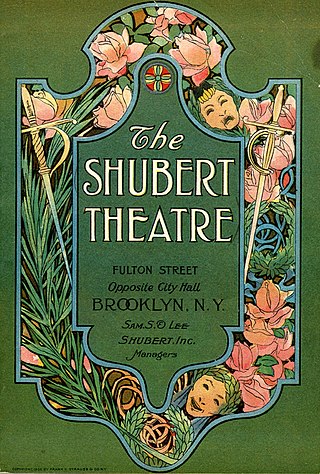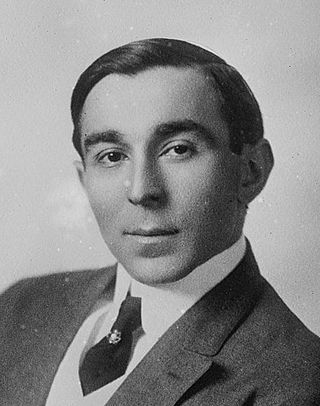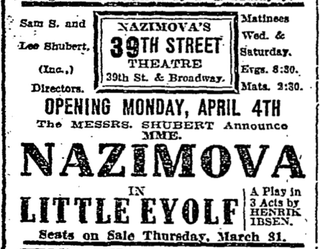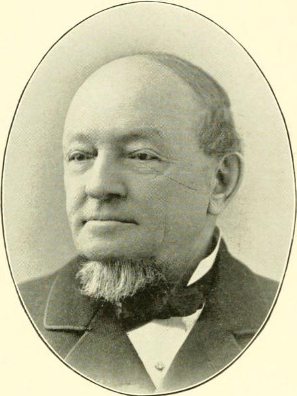
Broadway theatre, or Broadway, are the theatrical performances presented in the 41 professional theatres, each with 500 or more seats, located in the Theater District and the Lincoln Center along Broadway, in Midtown Manhattan, New York City. Broadway and London's West End together represent the highest commercial level of live theater in the English-speaking world.

The Shubert Organization is a theatrical producing organization and a major owner of theatres based in Manhattan, New York City. It was founded by the three Shubert brothers in the late 19th century. They steadily expanded, owning many theaters in New York and across the United States. Since then it has gone through changes of ownership, but it is still a major theater chain.
The Shubert family was responsible for the establishment of the Broadway district, in New York City, as the hub of the theatre industry in the United States. They dominated the legitimate theater and vaudeville in the first half of the 20th century, promoting entertainment attuned to popular taste.

Lee Shubert was a Lithuanian-born American theatre owner/operator and producer and the eldest of seven siblings of the theatrical Shubert family.

Samuel S. Shubert was an American producer and theatre owner/operator. He was the middle son in the Shubert family and was raised in Syracuse, New York.

The Shubert Theatre is a Broadway theater at 225 West 44th Street in the Theater District of Midtown Manhattan in New York City. Opened in 1913, the theater was designed by Henry Beaumont Herts in the Italian Renaissance style and was built for the Shubert brothers. Lee and J. J. Shubert had named the theater in memory of their brother Sam S. Shubert, who died in an accident several years before the theater's opening. It has 1,502 seats across three levels and is operated by The Shubert Organization. The facade and interior are New York City landmarks.

Archimedes Russell was an American architect most active in the Syracuse, New York area.

The Syracuse University Alma Mater is the school song for Syracuse University. It was written by Junius W. Stevens in 1893, and is based on the then-popular Irish melody Annie Lisle. It was first sung under the title "Song of Syracuse" by the University Glee and Banjo Club on March 15, 1893 at the Wieting Opera House.

The State Tower Building is a high-rise building located in Syracuse, New York. Completed in 1928, the building remains the highest in Syracuse. It has around 23 floors and is around 312 feet tall. For several years after the Bastable Theatre burnt down in a 1923 fire, the plot of land was considered as the potential site of a new theatre or an office building. Eventually the plot's owners, Central Offices decided to build an office building. Designed by Thompson & Churchill, work began on the foundation of the State Tower Building in 1927. The tower was completed by late April 1928.


Clinton Square is an intersection in downtown Syracuse, New York, United States. The square was the original town center and first came into existence in the early 19th century where roadways from north and south convened. With the opening of the Erie Canal in 1825 the intersection was further transformed. During the 19th century, the square was a marketplace that also hosted several public events, including an 1870 public barbecue reportedly attended by 20,000 people.

Julian Edwards was an English composer of light operatic music, who composed many successful Broadway shows in the Progressive Era. He attempted to introduce new levels of musical sophistication to the genre. Some of his songs achieved popularity at the time.

The Bronx Opera House is a former theater, part of the Subway Circuit, now converted into a boutique hotel in the Bronx, New York City. It was designed by George M. Keister and built in 1913 at 436 East 149th Street on the site of Frederick Schnaufer's stable. It was one of several theaters to come into the area that became known as the Hub. It was formally dedicated on opening night Saturday, August 30, 1913.

George Edwards "Georgie" Price was an American vaudeville singer and comic who performed in Vitaphone shorts in the 1920s and 1930s.

Klaw and Erlanger was an entertainment management and production partnership of Marc Klaw and Abraham Lincoln Erlanger based in New York City from 1888 through 1919. While running their own considerable and multi-faceted theatrical businesses on Broadway, they were key figures in the Theatrical Syndicate, the lucrative booking monopoly for first-class legitimate theaters nationwide.

The 39th Street Theatre was a playhouse in New York City located at the corner of 39th Street and Broadway. Originally called Nazimova's 39th Street Theatre after the actress Alla Nazimova, it was in operation from 1910 to 1925 when it was demolished to make way for an office building. Throughout its existence, it was owned by the Shubert family. Its architect was William Albert Swasey, who had designed or remodelled several other Broadway theatres for the family.

John Manchester Wieting was an American lecturer and philanthropist. He spent his early years as a teacher and then as an engineer and grader. After moving to Syracuse, New York, he read medicine to become a physician. After purchasing anatomical models he began giving lectures across upstate New York, gradually expanding the reach and the size of his lectures. They were extravagant affairs, and Wieting became known as one of the era's most prominent anatomical lecturers.

Mary Elizabeth Wieting Johnson was an American opera house manager and philanthropist who ran the Wieting Opera House in Syracuse, New York, after the death of her husband, John Wieting. She oversaw management of the Wieting Opera House and its reconstruction after it burned down for the third time in 1896.

The Wieting Opera House was a performance hall in Syracuse, New York, that hosted operas, films, and other performances from 1852 to 1930. Initially built by John Wieting in 1852 as Wieting Hall, the building burnt down in 1856. He rebuilt it that year, and in 1870 renovated the hall into an opera house. Towards the end of the 19th century, the opera house was a major theater in the Eastern United States, and held test performances of shows that were bound for performance on Broadway in New York City. The opera house burnt down in 1881 and 1896, and was rebuilt both times, the second time by Wieting's wife, Mary Elizabeth Wieting. The opera house began showing movies in the early 20th century, and closed in 1930, when it was replaced with a parking garage.

The Wedding Day is a comic opera in three acts with music by Julian Edwards and a libretto by Stanislaus Stange. Prior to a production on Broadway, the work premiered for the grand opening of the newly renovated Wieting Opera House in Syracuse, New York, on September 15, 1896. It was staged at The Boston Theatre where it began a two-week run on February 7, 1897. Critic Roland Burke Hennessy of The Illustrated American wrote, "I consider The Wedding Day to be by far the best native comic opera we have had in many a year."




















